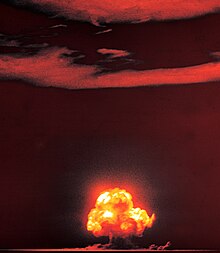مئنهٽن پروجيڪٽ
| Manhattan District | |
|---|---|
 The Trinity test of the Manhattan Project on 16 July 1945 was the first detonation of a nuclear weapon. | |
| سرگرم | 1942–1946 |
| تحليل | 15 August 1947 |
| ملڪ |
|
| شعبو | U.S. Army Corps of Engineers |
| گيريزن صدر مقام | Oak Ridge, Tennessee, U.S. |
| ساليانا موقعا | 13 August 1942 |
| جنگي سرگرميون | |
| ڪمانڊر | |
| مشھور ڪمانڊر | |
| Insignia | |
| Manhattan District shoulder sleeve insignia |  |
مئنهٽن پروجيڪٽ (Manhattan Project) هڪ ريسرچ ۽ ڊولپمينٽ پروگرام هو جيڪو ٻي مهاڀاري جنگ دوران پهريون ايٽمي هٿيار تيار ڪرڻ لاءِ شروع ڪيو ويو هو. ان جي اڳواڻي آمريڪا برطانيه ۽ ڪينيڊا جي تعاون سان ڪئي. سال 1942ع کان 1946ع تائين، منصوبي جي نگراني يو ايس آرمي ڪور آف انجنيئرز جو ميجر جنرل ليسلي گروز ڪئي. نيوڪليئر طبيعيات دان، رابرٽ اوپنهائيمر لاس الاموس ليبارٽري جو ڊائريڪٽر هو جنهن ائٽم بم ٺاهيو. آرمي پروگرام کي مئنهٽن ضلعي جو نالو ڏنو ويو، جيئن ان جو پهريون هيڊ ڪوارٽر مئنهٽن ۾ هو؛ نالو تدريجي طور تي پوري منصوبي لاءِ سرڪاري ڪوڊنيم، ڊولپمينٽ آف آلٽرنيٽ مٽيريل، کي ختم ڪري ڇڏيو. پروجيڪٽ پنهنجي اڳوڻي برطانوي هم منصب، ٽيوب الائيز کي جذب ڪيو ۽ پروگرام کي آمريڪي شهري آفيس برائي سائنٽيفڪ ريسرچ اينڊ ڊولپمينٽ کان شامل ڪيو. مئنهٽن پروجيڪٽ پنهنجي عروج تي لڳ ڀڳ 1,30,000 ماڻهن کي روزگار ڏنو ۽ لڳ ڀڳ 2 ارب آمريڪي ڊالر (سال 2023ع ۾ تقريبن 27 ارب آمريڪي ڊالر جي برابر) جي لاڳت هئي، جنهن مان 80 سيڪڙو کان وڌيڪ انهن پلانٽس جي تعمير ۽ هلائڻ لاءِ هو جيڪي فشل مواد پيدا ڪندا هئا. تحقيق ۽ پيداوار آمريڪا، برطانيه ۽ ڪئناڊا ۾ 30 کان وڌيڪ سائيٽن تي ٿي چڪي هئي.
The Manhattan Project was a research and development program undertaken during World War II to produce the first nuclear weapons. It was led by the United States in collaboration with the United Kingdom and Canada. From 1942 to 1946, the project was directed by Major General Leslie Groves of the U.S. Army Corps of Engineers. Nuclear physicist J. Robert Oppenheimer was the director of the Los Alamos Laboratory that designed the bombs. The Army program was designated the Manhattan District, as its first headquarters were in Manhattan; the name gradually superseded the official codename, Development of Substitute Materials, for the entire project. The project absorbed its earlier British counterpart, Tube Alloys, and subsumed the program from the American civilian Office of Scientific Research and Development. The Manhattan Project employed nearly 130,000 people at its peak and cost nearly US$2 billion (equivalent to about $سانچو:Inflation billion in سانچو:Inflation/year),سانچو:Inflation-fn over 80 percent of which was for building and operating the plants that produced the fissile material. Research and production took place at more than 30 sites across the US, the UK, and Canada.
The project resulted in two types of atomic bombs, developed concurrently during the war: a relatively simple gun-type fission weapon and a more complex implosion-type nuclear weapon. The Thin Man gun-type design proved impractical to use with plutonium, so a simpler gun-type design called Little Boy was developed that used uranium-235. Three methods were employed for uranium enrichment: electromagnetic, gaseous, and thermal. In parallel with the work on uranium was an effort to produce plutonium. After the feasibility of the world's first artificial nuclear reactor, the Chicago Pile-1, was demonstrated in 1942 at the Metallurgical Laboratory in the University of Chicago, the project designed the X-10 Graphite Reactor and the production reactors at the Hanford Site, in which uranium was irradiated and transmuted into plutonium. The Fat Man plutonium implosion-type weapon was developed in a concerted design and development effort by the Los Alamos Laboratory.
The project was also charged with gathering intelligence on the German nuclear weapon project. Through Operation Alsos, Manhattan Project personnel served in Europe, sometimes behind enemy lines, where they gathered nuclear materials and documents, and rounded up German scientists. Despite the Manhattan Project's emphasis on security, Soviet atomic spies penetrated the program.
The first nuclear device ever detonated was an implosion-type bomb during the Trinity test, conducted at White Sands Proving Ground in New Mexico on 16 July 1945. Little Boy and Fat Man bombs were used a month later in the atomic bombings of Hiroshima and Nagasaki, respectively. In the immediate postwar years, the Manhattan Project conducted weapons testing at Bikini Atoll as part of Operation Crossroads, developed new weapons, promoted the development of the network of national laboratories, supported medical research into radiology and laid the foundations for the nuclear navy. It maintained control over American atomic weapons research and production until the formation of the United States Atomic Energy Commission (AEC) in January 1947. مئنهٽن پروجيڪٽ (Manhattan Project) هڪ ريسرچ ۽ ڊولپمينٽ پروگرام هو جيڪو ٻي مهاڀاري جنگ دوران پهريون ايٽمي هٿيار تيار ڪرڻ لاءِ شروع ڪيو ويو هو. ان جي اڳواڻي آمريڪا برطانيه ۽ ڪينيڊا جي تعاون سان ڪئي. سال 1942ع کان 1946ع تائين، منصوبي جي نگراني يو ايس آرمي ڪور آف انجنيئرز جو ميجر جنرل ليسلي گروز ڪئي. نيوڪليئر طبيعيات دان، رابرٽ اوپنهائيمر لاس الاموس ليبارٽري جو ڊائريڪٽر هو جنهن ائٽم بم ٺاهيو. آرمي پروگرام کي مئنهٽن ضلعي جو نالو ڏنو ويو، جيئن ان جو پهريون هيڊ ڪوارٽر مئنهٽن ۾ هو؛ نالو تدريجي طور تي پوري منصوبي لاءِ سرڪاري ڪوڊنيم، ڊولپمينٽ آف آلٽرنيٽ مٽيريل، کي ختم ڪري ڇڏيو. پروجيڪٽ پنهنجي اڳوڻي برطانوي هم منصب، ٽيوب الائيز کي جذب ڪيو ۽ پروگرام کي آمريڪي شهري آفيس برائي سائنٽيفڪ ريسرچ اينڊ ڊولپمينٽ کان شامل ڪيو. مئنهٽن پروجيڪٽ پنهنجي عروج تي لڳ ڀڳ 1,30,000 ماڻهن کي روزگار ڏنو ۽ لڳ ڀڳ 2 ارب آمريڪي ڊالر (سال 2023ع ۾ تقريبن 27 ارب آمريڪي ڊالر جي برابر) جي لاڳت هئي، جنهن مان 80 سيڪڙو کان وڌيڪ انهن پلانٽس جي تعمير ۽ هلائڻ لاءِ هو جيڪي فشل مواد پيدا ڪندا هئا. تحقيق ۽ پيداوار آمريڪا، برطانيه ۽ ڪئناڊا ۾ 30 کان وڌيڪ سائيٽن تي ٿي چڪي هئي.
